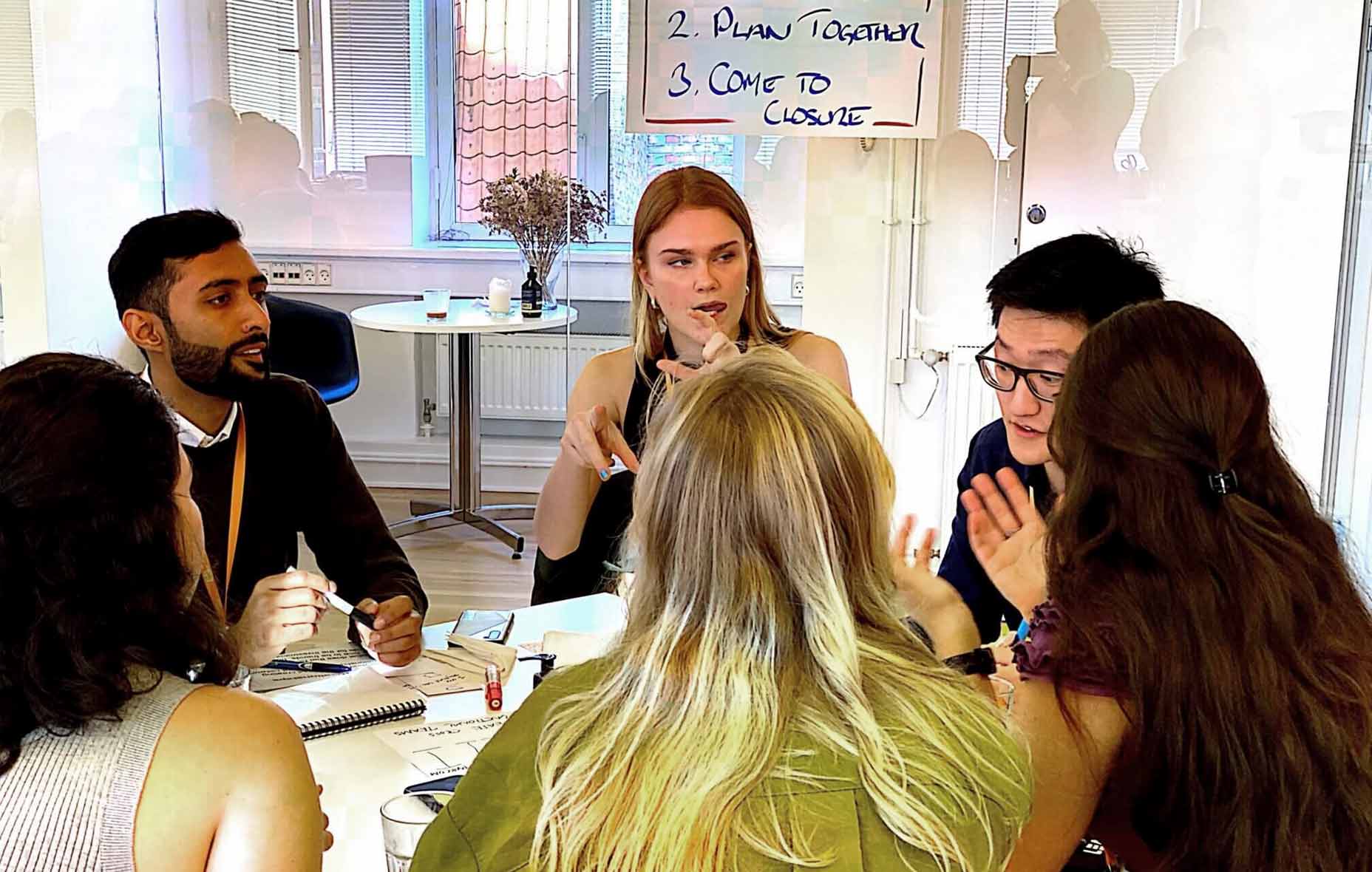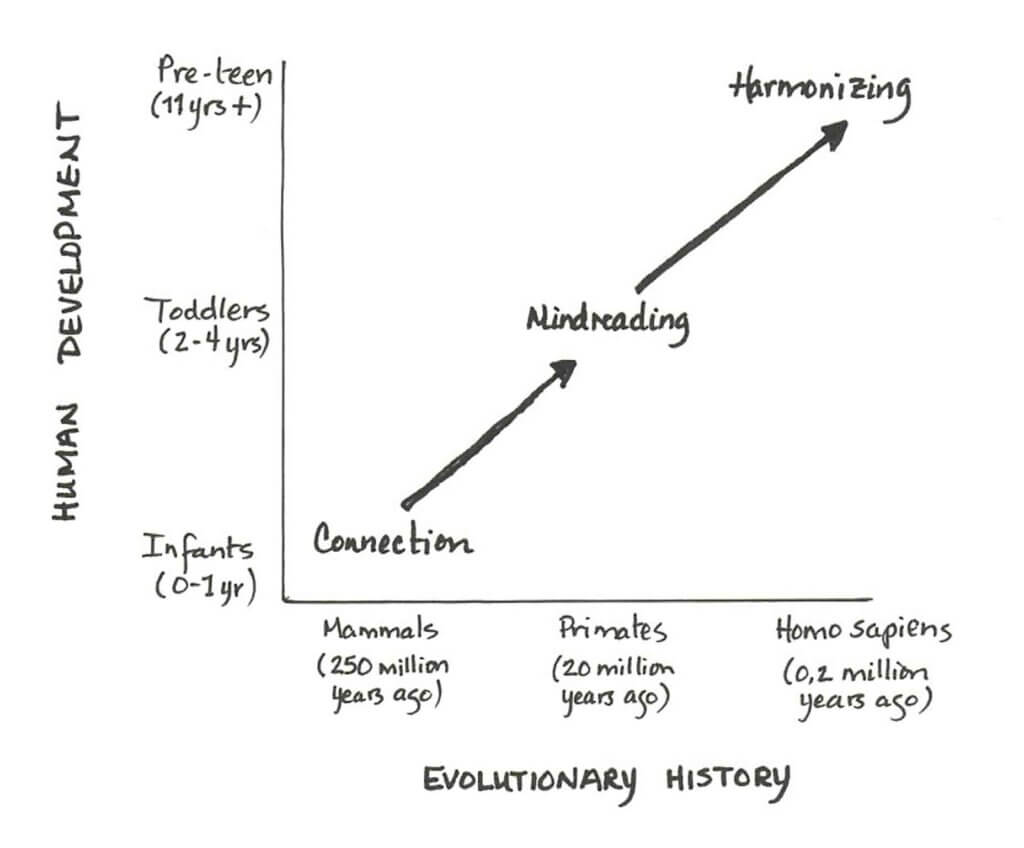Together – take advantage of how we’re wired to get results

There’s a lot of togetherness in today’s agile organizations. Working together does bring results. Did you know, though, that seeking social connections are things we humans do naturally? Our brains are wired to connect. Take advantage of this and you’ll more easily delight your coworkers, customers and stakeholders every day.
Social connections are complicated. Not only are we keeping track of ourselves (what we’re doing and thinking), we’re also trying to keep track of what others are thinking and doing. It requires high-level thought engaging the brain’s neocortex. Why do we do it? Because humans have evolved over thousands of years to be social.
It is one of our fundamental needs, just like food and water – and is just as critical to our survival.
Our brains send pain signals to the body when our fundamental needs are not met. And like hunger or thirst, being disconnected socially also activates the brain’s pain circuitry – pushing us to get that need for closeness met.
When we have social support, our brains decrease levels of the stress hormone cortisol and increase release of the feel-good hormones oxytocin and serotonin.
While we’re born seeking connection, our social development becomes more sophisticated as we mature. By the time we are teenagers, we are able to connect, mentalize, and harmonize with others – figure 1.
Connecting is the need for attachment between parents and children, lovers, friends. Social support, a mother’s voice or hug helps us as individuals to grow and thrive. (1) This is a basic need and oxytocin (the trust or love hormone) is released when we touch, giving us the feeling that all is right in the world.
Oxytocin lowers blood pressure, decreases stress hormones, and increases our sense of trust. And when we are spending nearly one quarter of our time at work, this feeling of attachment in organizations matters, too. It helps keep us engaged and motivated.
Mentalizing comes next, beginning around age 2 or 3 years old. This is where we are making sense of the thoughts, feelings and intentions of others. We are trying to figure out how to avoid social pain and move toward social pleasure. We do this without thinking about it.
Neuroscience research shows that 75% of the time we are not concentrating on solving a particular task or something we have to do, we are thinking about our social relationships or mentalizing. (This has been shown in fMRI studies that reveal the social thinking area of the brain is turned on.)(2)
Mentalizing is the brain’s default network – thinking about others is what we do when we stop thinking about the things we need to do. We are social thinkers naturally.
Finally, harmonizing begins in the pre-teen years. This is when we have self-knowledge, and the ability to set aside our own thoughts and actions and see things from others’ perspectives. What the neuroscience shows is that we are shaped by others’ beliefs and values and we shape others around us.(3)
According to Matthew D. Lieberman, Professor at UCLA Department of Psychology, Psychiatry & Biobehavioral Sciences, “Having our beliefs and values injected in us from the outside (without us realizing it) yields greater harmonizing among people in groups and leads to an improved balance of social pains and pleasures.“ It also allows us to work better together and have deeper, richer relationships, and more collaborative teams and organizations.
Yes, humans are wired to connect with others, but what does this mean in terms of our ability to deliver value faster? How can team members and leaders at every level capitalize on what we do naturally?
Think about social well-being to get to high performance
In order to get to high-performance where people in organizations delight customers every day, leaders need to think about the social well-being of their people. Studies show that not paying attention to people’s social well-being is likely to harm team performance and individual team member’s health.(4)
Encouraging strong relationships via faceto-face meetings is the fastest way to build trust. We need to hear people’s voices, see their expressions, read their body language, and have the ability to touch – okay, here I mean, just a pat on the back or a high five, or perhaps a friendly hug. Even just a simple touch releases oxytocin.
Keeping teams together so that the team members are not constantly trying to figure out “friend or foe“ (is this person going to help me or hurt me?) is another way we can increase trust and motivation. When we know where other people are at and we see them as a friend, we can stop mentalizing about them, work across the organization together as one trusted team, and focus on delivering results.
We also know that leaders and team members need to feel valued and express that they value others. When we feel what we do is important – understanding how we benefit others – the neurotransmitter dopamine is released signaling reward or pleasure in the brain. Studies show this also increases our ability to get to better solutions faster.(5)
Create the environment to support success
As social animals, even the most introverted of us need to feel we belong and build relationships that help us get things done. We can do a lot in the workplace to support this by creating the environment to support it. Making sure we have the opportunity to talk with each other – share ideas, ask questions.

Find meeting space; prioritize time for face-to-face meetings and workshops, and encourage each other to get up and walk over and TALK to people rather than relying on email for communication. How we talk about others in our organization also makes a difference between feeling connected to them or not. Try getting rid of the words “they” and “them”.
L. David Marquet, leadership expert and author of Turn the Ship Around! says, “How people talk about their colleagues in their organization has a profound effect on their feeling of togetherness. Simply saying ‘we’ and ‘us’ changes how we think.” Indeed, the research supports this.
In his book Social, Matthew D. Lieberman writes: “Efforts to make the group actually feel like a group will be rewarded, as team members start to better identify with the team. This will facilitate the kind of harmonizing that will promote individuals thinking about how they can best serve the team, rather than themselves. As social animals, we are wired to do this, as long as we really identify with the team.”(6)
The success of our projects, and delivering value to delight our customers, can be enhanced when we think of our co-workers across all areas of the organization as part of our team.
5 tips to take advantage of our wiring
1. Take time to build relationships across the organization – when we feel we are “in this together” we get better results.
2. Thank people and praise good work – the brain reacts just as well to social rewards as it does to monetary rewards.
3. Make sure people understand the value they will get personally from cooperating with others – cooperation increases the release of dopamine, the brain’s reward neurotransmitter helping us think better.
4. Tell stories about people and the work – stories engage and encourage the release of oxytocin increasing feelings of trust and well-being.
5. Find ways to be more positive – positivity shifts your core view of people and relationships, bringing them closer to you.
Noter
1 “Social vocalizations can release oxytocin in humans“, Leslie J. Seltzer, Toni E. Ziegler, Seth D. Pollak, Proceedings of the Royal Society B Biological Sciences, 12 May 2010.
2 “Counterfactual thinking: an fMRI study on changing the past for a better future“, Van Hoeck, Ma, Ampe, Baetens, Vandekerckhove, Van Overwalle, Social Cognitive and Affective Neuroscience, June 2013, 556-564.
3 “Values, Beliefs, and Proenvironmental Action: Attitude Formation Toward Emergent Attitude Objects“, Stern, Kalof, Dietz, Guagnano, Journal of Applied Social Psychology, September 1995.
4 “Work, psychological wellbeing and performance“, Daniels and Harris, Occupational Medicine, vol.50. No. 5, 304-309, 2000.
5 Give and Take: A Revolutionary Approach to Success, Grant, 2013; “Catecholamine modulation of prefrontal cortex function“, Arnsten, Trends in Cognitive Science, Vol. 2, 11, November 1998.
6 Social – Why Our Brains Are Wired to Connect, Lieberman, 2013.

Product
Enable Agile leadership
New ways of working require new ways of leading. Agile leaders create environments where people thrive.